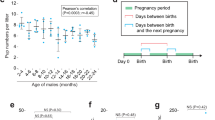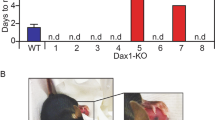Abstract
SOME chromosomal XY male humans1, mice2,3 and rats4 are born with a vagina, labia and clitoris instead of scrotum and penis. The expression of the female phenotype in these individuals is thought to be due to an insensitivity to androgenic hormones which are secreted by the testes. This phenomenon has been termed the androgen-insensitivity syndrone or testicular feminisation. Typically, androgen-insensitive humans are identified and adopt a female gender identity5. Androgen-insensitive rats, on the other hand, seem to be incapable of showing a high degree of feminine behaviour in adulthood even when given oestrogen and progesterone6,7. It is shown here that androgen-insensitive male rats are capable of responding to ovarian hormones with the display of feminine sexual behaviour if they are castrated at birth but not when castrated 10 d after birth. Although these rats are insensitive to their testicular secretions in terms of genital differentiation, the neural substrate of sexual behaviour is differentiated by the presence of testes during the first few days after birth.
This is a preview of subscription content, access via your institution
Access options
Subscribe to this journal
Receive 51 print issues and online access
$199.00 per year
only $3.90 per issue
Buy this article
- Purchase on Springer Link
- Instant access to full article PDF
Prices may be subject to local taxes which are calculated during checkout
Similar content being viewed by others
References
Morris, J. M. Am. J. Obstet. Gynec. 65, 1192 (1953).
Lyon, M. F. & Hawkes, S. G. Nature 227, 1217 (1970).
Ohno, S. & Lyon, M. F. Clin. Genet. 1, 121 (1970).
Stanley, A. J. & Gumbreck, L. G. Proc. endocr. Soc. 46, 40 (1964) Abst.
Money, J., Ehrhardt, A. A. & Masica, D. N. Johns Hopkins med. J. 123, 105 (1968).
Shapiro, B. H., Goldman, A. S., Steinbeck, H. F. & Neumann, F. Experientia 15, 650 (1976).
Beach, F. A. & Buehler, M. G. Endocrinology 100, 197 (1977).
Naftolin, F. et al. Recent Prog. Horm. Res. 31, 295 (1975).
Reddy, V. V., Naftolin, F. & Ryan, K. J. Endocrinology 94, 117 (1974).
Weisz, J. & Gibbs, C. Neuroendocrinology 14, 72 (1974).
Lieberburg, I. & McEwen, B. S. Brain Res. 85, 165 (1975).
Maclusky, N. J., Chaptal, C., Lieberburg, I. & McEwen, B. S. Brain Res. 114, 158 (1976).
Whalen, R. E. & Edwards, D. A. Anat. Rec. 157, 173 (1967).
McDonald, P. G. & Doughty, C. J. Endocr. 61, 95 (1974).
Whalen, R. E. & Rezek, D. L. Horm. Behav. 5, 125 (1974).
Clemens, L. G. in Reproductive Behavior (eds Montagna, W. & Sadler, W. A.) 23–53 (Plenum, New York, 1974).
Booth, J. E. J. Endocr. 72, 53P Abstr. (1976).
McEwen, B. S., Lieberburg, I., Chaptal, C. & Krey, L. C. Horm. Behav. 9, 249 (1977).
Rosenfeld, J. M., Daley, J. D., Ohno, S. & YoungLai, E. V. Experientia 33, 1392 (1977).
Fox, T. O. Proc. natn. Acad. Sci. U.S.A. 72, 4303 (1975).
Van Look, P. F. A., Hunter, W. M., Corker, C. C. & Baird, D. T. Clin. Endocr. 7, 353 (1977).
Aono, T., Miyake, A., Kinugasa, T., Kurachi, K. & Matsumoto, K. Acta endocr. 87, 259 (1978).
Shapiro, B. H. & Goldman, A. S. Horm. Behav. 4, 371–375 (1973).
Givens, J. R. et al. New Engl. J. Med. 291, 938 (1974).
Imperato-McGinley, J., Guerrero, L., Gautier, T. & Peterson, R. E. Science 186, 1213 (1974).
Author information
Authors and Affiliations
Rights and permissions
About this article
Cite this article
OLSEN, K. Androgen-insensitive rats are defeminised by their testes. Nature 279, 238–239 (1979). https://doi.org/10.1038/279238a0
Received:
Accepted:
Issue Date:
DOI: https://doi.org/10.1038/279238a0
This article is cited by
-
The Brain as the Engine of Sex Differences in the Organization of Movement in Rats
Archives of Sexual Behavior (2008)
-
Development of male gender identity/role and a sexual orientation towards women in a 46,XY subject with an incomplete form of the androgen insensitivity syndrome
Archives of Sexual Behavior (1991)
Comments
By submitting a comment you agree to abide by our Terms and Community Guidelines. If you find something abusive or that does not comply with our terms or guidelines please flag it as inappropriate.



